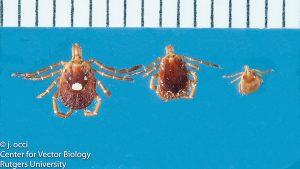
SHARE THIS ARTICLE:
Arkansas Community Scientist Study on Tick Distribution and Ehrlichia & Rickettsia
 Dowling, A., et al., published a report in Journal of Medical Entomology with the results of a cooperative effort to survey ticks throughout Arkansas to better understand the heavy impacts of TBDs such as spotted fever rickettsiosis, and ehrlichiosis in the mid-south. Logistical and financial barriers, and an expanding geographic area of concern, prompted researchers to collaborate with members of the public to gather data on human disease-causing pathogens carried by ticks. The 20-month period study focused on ticks that encounter humans most often. Arkansans contributed 9,002 ticks collected from 71 of the state’s 75 counties.
Dowling, A., et al., published a report in Journal of Medical Entomology with the results of a cooperative effort to survey ticks throughout Arkansas to better understand the heavy impacts of TBDs such as spotted fever rickettsiosis, and ehrlichiosis in the mid-south. Logistical and financial barriers, and an expanding geographic area of concern, prompted researchers to collaborate with members of the public to gather data on human disease-causing pathogens carried by ticks. The 20-month period study focused on ticks that encounter humans most often. Arkansans contributed 9,002 ticks collected from 71 of the state’s 75 counties.
The Amblyomma americanum (lone star tick) was the most commonly found– 76% of all ticks in the study. Of the ~ 6,000 screened ticks, the prevalence rate was 37.4% for Rickettsia (SFGR-spotted fever group Rickettsia) and 5.1% for Ehrlichia. One hundred forty-five ticks (2.5%), were simultaneously infected with SFGR and Ehrlichia. During the study period, Arkansas Department of Health reported 2,281 spotted fever and 380 ehrlichiosis cases.
Dermacentor variabilis (American dog tick) and Amblyomma maculatum (Gulf Coast tick) were not the most frequently submitted ticks, nor did they have the highest occurrence of SFGR. Therefore, the researchers speculate that other tick species seem to play the primary role in infecting humans with SFGR.
Read the report in Journal of Medical Entomology.





